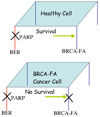BRCA-FA pathway as a target for anti-tumor drugs
- PMID: 18473727
- PMCID: PMC2564853
- DOI: 10.2174/187152008784220285
BRCA-FA pathway as a target for anti-tumor drugs
Abstract
Promising research on DNA repair signaling pathways predicts a new age of anti-tumor drugs. This research was initiated through the discovery and characterization of proteins that functioned together in signaling pathways to sense, respond, and repair DNA damage. It was realized that tumor cells often lacked distinct DNA repair pathways, but simultaneously relied heavily on compensating pathways. More recently, researchers have begun to manipulate these compensating pathways to reign in and kill tumor cells. In a striking example it was shown that tumors derived from mutations in the DNA repair genes, of BRCA-FA pathway, were selectively sensitive to inhibition of the base excision repair pathway. These findings suggest that tumors derived from defects in DNA repair genes will be easier to treat clinically, providing a streamlined and targeted therapy that spares healthy cells. In the future, identifying patients with susceptible tumors and discovering additional DNA repair targets amenable to anti-tumor drugs will have a major impact on the course of cancer treatment.
Figures


References
-
- Thompson LH. Nat Genet. 2005;37:921. - PubMed
-
- Howlett NG, Taniguchi T, Olson S, Cox B, Waisfisz Q, De Die-Smulders C, Persky N, Grompe M, Joenje H, Pals G, Ikeda H, Fox EA, D'Andrea AD. Science. 2002;297:606. - PubMed
-
- Moynahan ME, Cui TY, Jasin M. Cancer Res. 2001;61:4842. - PubMed
-
- Yun J, Zhong Q, Kwak JY, Lee WH. Oncogene. 2005 - PubMed
Publication types
MeSH terms
Substances
Grants and funding
LinkOut - more resources
Full Text Sources

